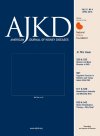AJKD Atlas of Renal Pathology: Oxalosis
Hyperoxaluria may be due to hereditary defects of key enzymes of oxalate metabolism, or secondary to excess intake or increased enteric absorption. Inherited forms are autosomal recessive; the most common, type 1, accounts for ∼80% of cases and presents in childhood with recurrent nephrolithiasis. About half of patients with childhood onset of nephrolithiasis develop end-stage kidney disease by age 15, with accompanying systemic oxalate deposits, including cardiovascular system, eyes, and bones.



